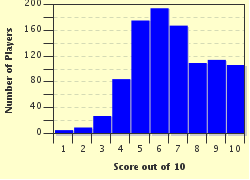Quiz Answer Key and Fun Facts
1. The first known North American explorers migrated across a land mass between Siberia and Alaska during the last Ice Age. What name did Swedish botanist Eric Hulten give to this land mass in 1937?
2. David Livingstone, a Scottish missionary and explorer, was the first European recorded as having seen which waterfall in Africa?
3. Portuguese explorer Antonio de Faria is recorded as the first European explorer to see the Mekong river in 1540. The river flows through several Asian countries, but in which of these does it reach the sea?
4. Situated in the river Danube in Budapest is an island first settled in the 12th century by the Knights of St. John. Since the 13th century it has been known by which name, after the daughter of King Béla IV of Hungary?
5. The Spanish invaders, under Gonzalo Pizarro, are believed to be the first Europeans to see the Colca Canyon in 1540. In which South American country is it situated?
6. Dr. and Mrs Leakey discovered the 1.75 million-year-old remains of Australopithecus bosei in the Olduvai Gorge. In which African National Park is the Gorge situated?
7. Located in Andalusia, Spain, on the banks of the Guadalquivir river, is a city which has been conquered by the Romans, the Visigoths and then captured by the Moors who built the Great Mosque, one of its most famous landmarks. It was conquered once again in 1236 by the Christian army of King Ferdinand III, so which of these is it?
8. Erik the Red was exiled from Iceland for three years as a punishment for killing several men. On his return he gathered immigrants to go back to his place of exile to form a new settlement there. To encourage them he gave his island what name?
9. The French missionary Jean-François Gerbillon was one of the earliest Europeans to describe the Gobi Desert while working in China. The Gobi Desert covers parts of China and which other Asian country?
10. In 1870 Charles Barrington Brown discovered which waterfalls, located on the Potaro river in Guyana?
Source: Author
rossian
This quiz was reviewed by FunTrivia editor
spanishliz before going online.
Any errors found in FunTrivia content are routinely corrected through our feedback system.

